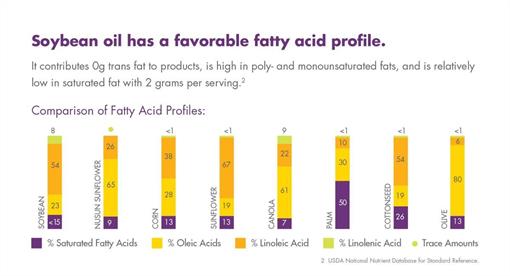
In recent years industry initiatives have drastically reduced the amount of trans fats consumed in the U.S. diet, but the concern now lies with what types of fats and oils should be used as replacements. The United Soybean Board (USB) is taking specific measures to help consumers eliminate trans fats in their diets. USB is working with the food industry to remove trans fats in packaged foods using high oleic soybean oil and innovative new processing methods. Liquid soybean oil is an option for consumers to use as part of a healthy diet.
Commonly labeled as vegetable oil on grocery store shelves, liquid soybean oil is the most widely used edible oil in the U.S.,1 and its popularity continues to grow as consumers look for trans fat replacements. The oil contains no trans fats, has only 2 grams of saturated fat, and is high in poly- and monounsaturated fats.2 Soybean oil is one of the few non-fish sources of omega-3s in the U.S. diet. 3 These fatty acids positively affect overall cardiovascular health, including reducing blood pressure and risk of heart disease.4, 5
Unlike other popular oils, the majority of soybean oil consumed in the United States is produced domestically,6 supporting U.S. farmers. More than 550,000 U.S. soybean farmers help put soybean oil on grocery store shelves. 7
Soybean oil has a neutral flavor and a well-balanced fatty acid profile. It is an affordable and desirable ingredient for many applications, such as pan frying, salad dressings and baked goods.
References:
1. U.S. Department of Agriculture, Economic Research Service: 2014 ERS Oilseed Yearbook.
2. USDA National Nutrient Database for Standard Reference.
3. PM Kris-Etherton, Denise Shaffer Taylor, et al. Polyunsaturated fatty acids in the food chain in the United States. Am J Clin Nutr. 2000 Jan; 71(1) 1: 179S-188S.
4. “Omega-3 fatty acids.” http://umm.edu/health/medical/altmed/supplement/omega3-fatty-acids#ixzz2.... University of Maryland Medical Center. 2013.
5. Harris WS, Mozaffarian D, Rimm E, et al. Omega-6 fatty acids and risk for cardiovascular disease: a science advisory from the American Heart Association Nutrition Subcommittee of the Council on Nutrition, Physical Activity, and Metabolism; Council on Cardiovascular Nursing; and Council on Epidemiology and Prevention. Circulation 2009;119:902-7.
6. U.S. Department of Agriculture, Oilseeds: World Markets and Trade, http://apps.fas.usda.gov/psdonline/circulars/oilseeds.pdf, December 2015.
7. Farm Size and the Organization of U.S. Crop Farming; Economic Research ReportNo. (ERR-152) 61 pp, August 2013